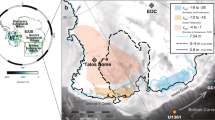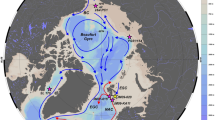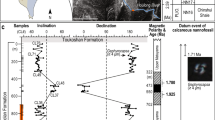Abstract
DETAILED analyses of deep-sea sediment cores have produced spectacular advances in the knowledge of Quaternary stratigraphy and palaeoclimates. These have allowed the rigorous testing of hypotheses put forward to explain climatic fluctuations1 and the construction of global atmospheric circulation models for dated periods in the past2. Unfortunately, these studies do not provide evidence of the important climatic variable, precipitation, changes in which could be critical to the understanding of glacial advance and retreat and to atmospheric circulation patterns generally. Only sequences from terrestrial sediments can provide the necessary information on precipitation. Here again the majority of dry land sequences are of limited value (with certain exceptions3,4) because they predominantly reflect temperature fluctuations or, where changes in effective precipitation are evident, sequences tend to be short or discontinuous. Here I outline and assess the significance of this sequence from tropical Australia which provides a long continuous precipitation record.
This is a preview of subscription content, access via your institution
Access options
Subscribe to this journal
Receive 51 print issues and online access
$199.00 per year
only $3.90 per issue
Buy this article
- Purchase on Springer Link
- Instant access to full article PDF
Prices may be subject to local taxes which are calculated during checkout
Similar content being viewed by others
References
Hays, J. D., Imbrie, J. & Shackleton, N. J. Science 194, 1121–1132 (1976).
CLIMAP Science 191, 1131–1137 (1976).
Wijmstra, T. A. Acta Bot. Neerl. 18, 511–527 (1969).
Wijmstra, T. A. & Smit, A. Acta Bot. Neerl. 25, 297–312 (1976).
Kershaw, A. P. Nature 251, 222–223 (1974).
Kershaw, A. P. New Phytol. 77, 469–498 (1976).
Kershaw, A. P. thesis, Australian National Univ. (1973).
Kershaw, A. P. New Phytol. 69, 785–805 (1970); 70, 669–681 (1971); 75, 173–191 (1975).
Webb, L. J. & Tracey, J. G. Austr. For. 31, 224–240 (1967).
Kershaw, A. P. 47th ANZAAS Congr. Hobart (1976).
Shackleton, N. J. & Opdyke, N. D. Quat. Res. 3, 39–55 (1973).
Sancetta, C., Imbrie, J. & Kipp, N. G. Quat. Res. 3, 110–116 (1973).
Nix, H. A. & Kalma, J. D. in Bridge and Barrier: The natural and cultural history of Torres Strait (ed. Walker, D.) 61–92 (Dept of Biogeography and Geomorphology. Publ. BG/3, A.N.U., Canberra, 1972).
Kershaw, A. P. & Nix, H. A. Australian Conf. Climate and Climatic Change Melbourne (1975).
Chappell, J. Nature 252, 199–202 (1974).
Author information
Authors and Affiliations
Rights and permissions
About this article
Cite this article
KERSHAW, A. Record of last interglacial–glacial cycle from northeastern Queensland. Nature 272, 159–161 (1978). https://doi.org/10.1038/272159a0
Received:
Accepted:
Issue Date:
DOI: https://doi.org/10.1038/272159a0
This article is cited by
-
Rapid global ocean-atmosphere response to Southern Ocean freshening during the last glacial
Nature Communications (2017)
-
Millennial and orbital variations of El Niño/Southern Oscillation and high-latitude climate in the last glacial period
Nature (2004)
-
Cryptic diversity in an endemic rainforest skink (Gnypetoscincus queenslandiae)
Biodiversity and Conservation (1993)
-
Bauxites gathering dust
Nature (1988)
-
Climatic change and Aboriginal burning in north-east Australia during the last two glacial/interglacial cycles
Nature (1986)
Comments
By submitting a comment you agree to abide by our Terms and Community Guidelines. If you find something abusive or that does not comply with our terms or guidelines please flag it as inappropriate.



